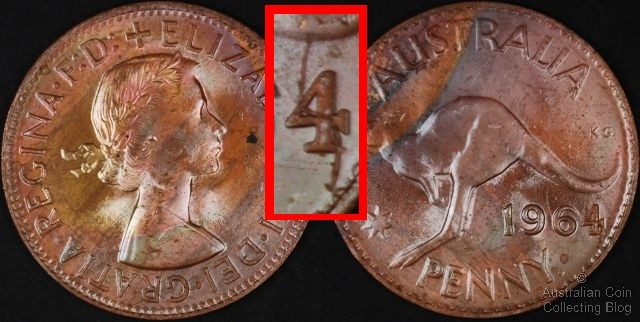 1964Y Penny Struck Through Wire or Cotton
1964Y Penny Struck Through Wire or CottonThe strike through or strike thru error term is given to an error observed on a coin where there is an incuse marking on the coin that looks as if there was something on or adhering to the coin surface at striking. This might me a piece of wire, metal or a piece of string or grease or some other foreign material. On occasions the foreign matter may still be stuck to the coin!
During cleaning or maintenance of the coin press, oil or grease needed to maintain the presses mechanical activity may get onto the surface of the die. If a coin is struck though oil then the resulting coin will have the appearance of a missing piece in the design or a poorly struck surface. It is also termed filled die or struck through grease filled die. This is often more impressive on a coin missing important features such as a letter in the date or even the entire date. The effect of a strike through oil may have the appearance that the surface (in that area) has been harshly cleaned or machined down, this is because of the texture of the foreign material and the concave impression it gives to the coin surface.
It is common to find coins struck with greasy or even rusty dies resulting in poorly struck surfaces, features or legends. This is really just poor quality control from the mints resulting in poor quality coins rather than collectable error coins. If the strike through is spectacular then expect a premium price for the coin.
It's important to look at both sides of the coin and if this weakness appears on both sides of the coin then it's not likely to be oil on the die but a thinned part of the planchet or if it's uniform around the coin may be a weak strike.

1962 Sixpence Struck Through Oil
There was an example I have seen of a strike through red cotton on the coin surface and the resulting struck coin still had the piece of red cotton attached! Fitters who work on the presses at the RAM use red rags to clean the presses and die surfaces. Seen in one of our previous articles are the fitters changing the dies on the gallery press and the red rag in use for clean up (see top image in link).
Posted by harrisk at February 15, 2010 12:50 PM
Subscribe to our Newsletter


